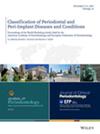Effect of an intensive antiplaque regimen on microbiome outcomes after nonsurgical periodontal therapy
Abstract
Background
It has been well documented that periodontal treatment decreases the levels of certain disease-associated species in subgingival plaque. Few studies, however, investigate to which extent periodontal therapy restores a health-like subgingival community. Here, we conducted a secondary analysis to evaluate microbiome outcomes of nonsurgical periodontal therapy alone or followed by an intensive antiplaque regimen, analyzing microbiome trajectories at the community level with respect to health.
Methods
Eighty-six subjects with periodontitis stages II/III were evaluated at baseline and 6 months after receiving scaling and root planing alone (SRP, n = 41) or followed by an antiplaque regimen consisting of use of 0.12% chlorhexidine for 3 months and interdental cleaners for 6 months (SRP + P + S, n = 45). Thirty periodontally healthy subjects served as reference. The subgingival microbiome was characterized by 16S rRNA gene sequencing, and longitudinal within-subject changes were quantified with respect to a healthy plane (HPL) modeled from the reference group.
Results
Evaluation of individual microbiome trajectories showed that only the SRP + P + S group had a statistically significant reduction in distance to the HPL. However, responses were variable in both groups, with only a fraction of individuals changing in the direction of health. Random forest analysis revealed baseline microbiome composition as a greater predictor of microbiome response than type of treatment rendered.
Conclusion
An adjunct antiplaque regimen resulted in a greater approximation of the microbiome to the healthy state. However, responses varied greatly among subjects highlighting the need for robust and personalized approaches to restore eubiosis.
Plain Language Summary
This study looked at how different treatments for gum disease change the bacteria in the gums of people with moderate to severe gum problems. Eighty-six people received standard gum treatments, and some also used a mouthwash and special tools to clean between their teeth at home. After 6 months, more people in the group that added the extra cleaning steps had healthier bacteria in their gums than people who received the standard treatment. However, not everyone responded the same way. The study found that the types of bacteria someone had at the start were better at predicting how well the treatment would work, more than the type of treatment itself. This means gum disease treatments may need to be personalized for better results.




 求助内容:
求助内容: 应助结果提醒方式:
应助结果提醒方式:


